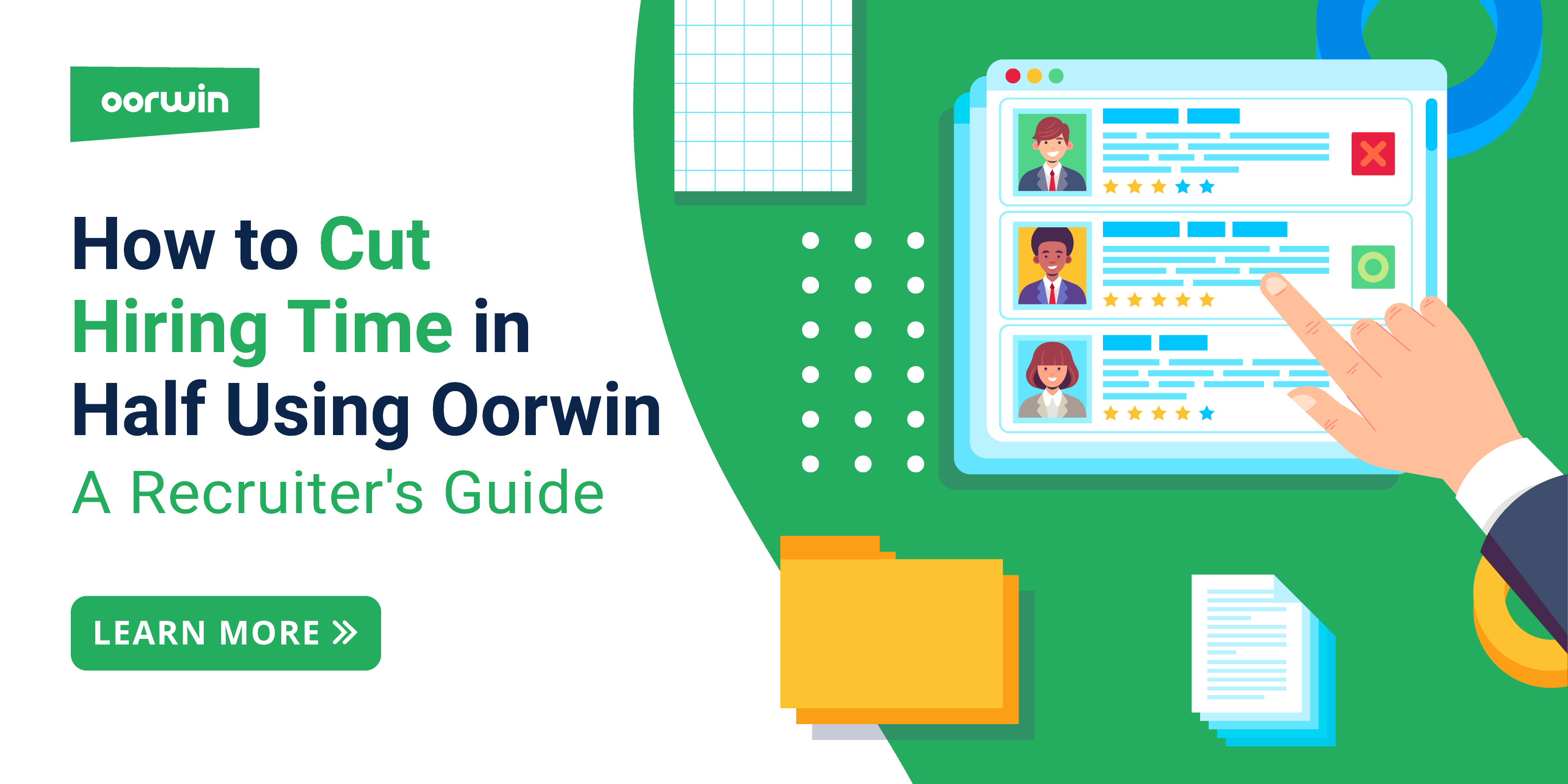7 Stages of the Full Life Cycle Recruitment
Oorwin
6min read / 10 Jul 2022

Related Articles
Recruiting is the lifeblood of any staffing organization. Therefore, any staffing business must develop a strategy to consistently attract and retain quality talent while ensuring maximum resource utilization. One of the most effective ways of increasing profitability and staying ahead of the curve is by designing a full recruitment cycle.
What is the Full Recruitment Life Cycle?
The full recruitment life cycle or full life cycle recruiting is the process that begins with a need or requirement for a candidate and ends when the candidate is successfully hired or placed. It encompasses everything from needing a new employee to onboarding your new hire.
Once we reach the end of the recruitment cycle, it starts again. This allows you to systematize your recruiting process. It also lets you constantly tweak your recruitment process so that you are making fewer mistakes and hiring increasingly outstanding employees.
Full life cycle recruitment is an integral part of any business’s success. It allows organizations to bring in the most suitable candidates for their open roles and ensure their satisfaction with the job and the company. While the full-cycle recruiting process can be time-consuming and labor-intensive, its rewards – cost-savings, improved brand reputation, and employee satisfaction – make it an invaluable part of any organization.
Who is Responsible for Conducting The Stages of the Full Life Recruitment Cycle?
The recruitment cycle process involves multiple stakeholders within an organization. The HR department manages the process, conducts resume screening, and coordinates interviews. Hiring managers have decision-making authority, provide input on job requirements, and participate in interviews. Interviewers, including managers, HR professionals, and team members, assess candidates’ qualifications and cultural fit. Assessment specialists may administer tests and assessments to evaluate candidates objectively. Together, these stakeholders collaborate to identify and select the most suitable candidates for the positions being recruited, ensuring a thorough and effective recruitment process.
7 Steps of the Full Life Cycle Recruiting Process
Now, let’s take an in-depth look at the seven stages of the recruitment cycle. All the stages work together to help you find and hire great employees for your company.
When describing these recruitment process steps, we will discuss them in the context of a company trying to fill one open position.
Stages of Recruitment Process Step 1 – Pre Recruitment Planning
It is vital to assess the specific needs of new employees, which includes researching the required skills and qualifications, analyzing the cost implications, and considering the new hire’s long-term role in the organization. Once crucial considerations have been established and the pre-recruitment plan has been created, the organization is ready to take the next step in the full life cycle recruitment process.
You’ll want to write a job description outlining all the requirements. A job description should include an overview of the job duties and responsibilities, the necessary qualifications and experience, and the desired competencies for success. It should also provide information about the working environment and the benefits of the role.
Stages of Recruitment Process Step 2 – Sourcing
Next is the sourcing stage. Here, you will want to search for active and passive candidates. Candidates can come from anywhere, so you’ll want to cast a wide net.
Some places you can source candidates include your website, social media websites (like LinkedIn), and job boards. Employee referrals are also an outstanding source of potential hires.
Stages of Recruitment Process Step 3 – Evaluation of Applicants
The third step is to assess the process at a fundamental reporting level by looking at what are known as conversion rates or click-through rates. This is the quantity or proportion of people who advance to the following phase. You can re-evaluate if a step excludes too many people unnecessarily if it has a high fallout rate.
This process management will contribute to a better candidate experience, aiding in advancing qualified applicants to the hiring stage. The ratio of clicks to applications on your job postings is one of the greatest KPIs to monitor. In the recruitment process, an adequate ATS will convert candidates quickly.
Stages of Recruitment Process Step 4 – Interview and Selection
This stage of the full life cycle recruitment process is critical for hiring the right fit for a role. Ensuring that the interview process is consistent and relevant for all potential candidates is essential. This may involve writing down specific questions for each candidate and noting key answers during the interviews.
The complete cycle recruiter must keep an eye on numerous balls at once. Scheduling has a significant role at this step of the full recruiting cycle. Planning and confirmation are required for candidate interviews. Assignments must be distributed, reviewed, and followed up with helpful feedback.
The hiring manager’s relationship with the recruiter is crucial to this process step. They ought to be touching closely. The hiring manager and the recruiter should continually communicate with the candidates’ shortlist, the latter’s comment on the candidates, iterating the requirements, etc.
Stages of Recruitment Process Step 5 – Hiring
The fifth stage is hiring. You’ll choose the qualified candidate you want to hire at this stage in the recruitment process. While this can be difficult, you must decide based on your hiring role.
Once selected, you will submit a formal offer letter to your candidate. It would be best if you were willing to answer any candidate’s questions before they accept the offer.
Stages of Recruitment Process Step 6 – Onboarding
Onboarding is the sixth stage. Upon the candidate accepting your offer, you will want to start familiarizing them with your organization and team.
This may include a formal orientation, mandatory training programs, and an organized lunch with the new hire and their colleagues. Take your time with this stage, as it is imperative to the future success of your new hire.
Stages of Recruitment Process Step 7 – Post-recruitment Evaluation
The final evaluation is the last stage of the full life cycle of recruitment. Once a new hire is onboarded, organizations should conduct a post-recruitment assessment to ensure the process is successful and efficient. This can involve tracking metrics such as how many days it took to fill the role and how much it cost to fill the position. This also serves as a valuable opportunity for the organization to review and revise any areas of the recruitment process that may have been problematic or inefficient.
Benefits of Full Cycle Recruiting
Here are some of the benefits of full-cycle recruiting for different resources in a recruitment process-:
A full recruitment life cycle can improve the recruiting and hiring efficiency of small to mid-size companies with fewer job openings. Companies can lower their hiring costs by eliminating the need for specialized roles, such as HR. This is particularly advantageous for companies with limited budgets.
Full life cycle recruiting provides recruiters a holistic understanding of the hiring process, allowing them to gain valuable experience onboarding new employees. This extended scope of responsibilities can help recruiters build stronger relationships with new hires and improve their overall job performance.
Challenges of Full Cycle Recruiting
A Single Point Of Failure
Having a single point of contact may also mean a single point of failure in the hiring process. If one person is responsible for everything from sourcing to onboarding, there may be a concern for delays if nobody else has been trained to do those tasks. Having another person learn these responsibilities as a backup for full-cycle recruiters is highly recommended, especially if only one is in the company.
Capacity Limitation
Recruiting is difficult even in highly competitive personnel marketplaces like the tech industry. For full-cycle recruiters, it’s essential to manage their time efficiently, given the added obligation of onboarding new workers. If you do, you can avoid burning out from working long hours. When it’s time to bring on more recruiters or HR operations and onboarding professionals, it’s crucial to consider how quickly a firm grows and how many people are hired. Companies may also consider using contract recruiters or staffing firms if the increase in hiring volume is short-term or seasonal.
Tools to Manage the Full Life Cycle Recruiting
With this background in mind, let’s discuss some helpful tools to help you manage the recruitment cycle.
You’ll want to invest in a high-quality Applicant Tracking System (ATS). ATS is a helpful tool that can help you manage every stage of the recruitment process. For instance, you can effortlessly search through candidates in your database and easily communicate with large groups of applicants.
This is a playful way of sourcing talent. You’ll learn about job search engines. You’ll be familiarized with them.
Finally, seriously consider creating an internal employee referral system. Studies show that some of the best hires come from referrals from current employees. You can also leverage this benefit—so long as you work to create a referral incentive system. Check G2Crowd’s top recruitment tools here.
Leveraging the Full Recruitment Cycle
The full recruitment cycle represents just one part of the staffing business.
As you likely know, most staffing companies have resource pools with a set of skills, experience, qualifications, etc. The staffing business needs more money than a resource pool candidate spends daily on the bench.
The recruitment cycle is an essential component of any staffing business. No matter the size of your company, we encourage you to leverage the recruitment cycle in your day-to-day work. Doing this can substantially increase your chances of accomplishing strategic staffing recruiting goals.
With an integrated approach to the staffing business, Oorwin helps you maximize profitability by dovetailing sales, recruitment, and HR processes.
Want to try Oorwin? You can request a product tour here.
Frequently Asked Questions
What is full life cycle recruitment?
Full life cycle recruitment is finding, attracting, and hiring the best-talented individuals for a job. It is the practice of managing the entire recruitment process, from job creation to onboarding to post-recruitment evaluation.
What are the benefits of full life cycle recruitment?
Full life cycle recruitment helps employers ensure that every step of the recruitment process is thorough and effective, leading to hiring the most suitable candidate. It also allows employers to optimize costs and prevent recruitment mistakes, such as hiring the wrong candidate or missing out on excellent prospects.
How can I improve my full recruitment cycle strategy?
The best way to improve a full life cycle recruitment strategy is to plan and implement all process stages carefully. This includes creating a clear job description, leveraging the organization’s network of professionals, conducting thorough interviews, and conducting a post-recruitment evaluation.
Popular Articles..
Blog

6min read / 25-Jun-2025
Master Effective Interview Techniques with Oorwin: A Step-by-Step Recruiter’s Guide
Blog
Blog
Get the latest Oorwin releases, updates, success stories & industry news
 Back
Back
